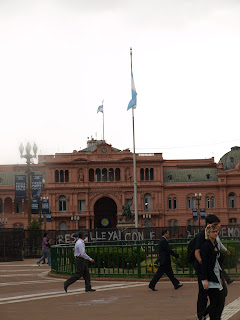Tales from the wrinklitourist and her brother as they creak their way around South America
Thursday, 15 December 2011
Recoleta Cementery - where's Evita?
Out on the busy streets of Buenos Aires for a walking tour of some of its nineteenth and early twentieth century architecture, we strolled down pedestrian Florida, hoping we might see some tango buskers in front of the magnificent Galerias Pacifico, with its painted vaulted ceilings, but they were obviously recovering from a late night's dancing;- perhaps we'll see them later. We crossed and recrossed the acacia-lined eighteen-lane Avenida 9 de julio, with its obelisk marking the raising of the national flag for the first time, and through leafy squares lined with elegant but solid neo-gothic statements of power.
It was a balmy 25 degrees or so, but the curse of the wrinklitourist was in full spate, with heavy rain showers punctuating our amble, and forcing us to take refuge in one of the arcades off Florida, which turned out to have the most magnificent pair of Art Nouveau entrance arches, all wrought iron, brass and marble. We took our café con leche in a small local bar and hit the trail again to Plaza de Mayo where we admired the pink Presidential palace, and moved as discreetly as possible around the Malvinas veterans' protest camp.
Then into a taxi and off to Recoleta Cemetery, an extraordinary necropolis of BA's wealthy. It is a maze of lanes, where there is no coyness about its purpose; each edifice (and some of them are twenty feet high or so) dedicated to storing the dead. You can see the coffins on their shelves, and peer through doors and grilles at images of the dead. Some of the tombs are ultra-modern, with plate-glass doors, and look like hotel lobbies until you see the remembrance plaques and altars inside. Some are beautiful examples of fin de siecle art. There were several being cleaned up (imagine that career path), washed and polished. This is a place which is still very much in use. Evita Duarte de Peron is interred there, and it is a place of pilgrimage, but her tomb is rather pedestrian by comparison with some of the more extravagant ones. There are some, however, which have for some reason been left to decay along with their occupants, broken slabs, shattered glass and weeds in the cracks. It's a strange place, we couldn't decide whether we liked the idea or not, but it was certainly worth the visit.
As was the nearby Museo de Bellas Artes, which houses a small, but startling collection which includes Goya, Velazquez, El Greco, Degas, Manet, Lautrec, Van Gogh, and my own particular favourite, Sorolla. They have three of his Valencian beach scenes which glow with light and the reflection of the sea on wood, skin and cloth. Truly extraordinary. I know that those sails are painted on a flat piece of canvas but I swear that there is a light behind them, and that they are flapping in the wind.
Subscribe to:
Post Comments (Atom)






Sounds like you're off to a good start. Have a wonderful time.
ReplyDelete